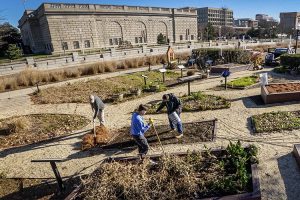Cover Crops Benefit Both Commercial Farmers and Urban Gardeners
NRCS National Plant Materials Center (PMC) staff David Kidwell-Slak (PMC Manager), Shawn Belt (Horticulturist), and Dan Dusty (Farm Manager).
By Nancy McNiff, Strategic Communications Coordinator, Farm Production and Conservation Business Center
Increasingly, farmers and even urban and backyard gardeners are realizing that cover crops are critical to their operations and gardens. Cover crops – plants grown primarily to benefit the successful growth of other future crops – help with soil erosion, improve soil health, crowd out weeds, control pests and diseases, increase biodiversity, and can bring a host of other benefits to your farm or garden, including increased profitability.
Cover crops can be planted any time of the year, but typically after your main crops have been harvested, usually in the fall, and they are grown until you plant your next crop in the spring.
In late 2021, the U.S. Department of Agriculture’s Plant Materials Center planted cover crops at the Department’s headquarters building in Washington, D.C. – an urban garden just a short walk from the Washington Monument.
David Kidwell-Slak, NRCS National Plant Materials Center Manager, and his team planted cereal rye, a cover crop that’s cold-weather hardy, that will help improve the soil and suppress winter weeds that may emerge.
First, they start with one of the raised beds, temporarily removing the drip irrigation system – a “game-changer” for the home or urban gardener or farmer, says Kidwell-Slak, because it provides water to a bed whenever it’s needed, making crops more productive.
Then comes preparing the bed by raking, removing, and saving the now-brown, bald cypress tree leaves they’ve used to keep the soil covered through the summer and fall. They spread the cereal rye seeds over the soil by hand and lightly rake them in to make sure there is good seed-to-soil contact.
Next, comes lightly tamping down the soil with the side of the rake to make sure the soil stays put and adding back the dry bald cypress leaves to cover all the bare soil. Lastly, the drip irrigation system is returned.
Cover Crops Protect Against Climate Changes and Improve Water Quality
Besides the many other benefits, cover crops remove CO2 from the atmosphere and help make your soil more resilient to a changing climate. They lead to better water infiltration and water holding capacity in the soil and make the soil less susceptible to erosion from wind and water. In addition, cover crops trap excess nitrogen – keeping it from leaching into groundwater or running off into surface water – releasing it later to feed growing crops. This is a win-win, saving you money on inputs like water and fertilizer and making crops better able to survive in harsh conditions.
“So, if you do cover crops year-after-year, you see improvements in soil health, which ultimately lead to more resilient soils, better crop yields, and more conservation of resources,” said Kidwell-Slak.
More Information
NRCS provides technical and financial assistance to help farmers plant cover crops through the Environmental Quality Incentives Program. NRCS also launched a new Cover Crop Initiative on January 10, which provided additional support for cover crops in 11 states.
Meanwhile, USDA has made other strides to support cover crops through Federal crop insurance. In 2021, USDA provided a premium benefit to help producers with crop insurance maintain cover crops amid the pandemic as well as enacted other flexibilities.
To learn more, visit farmers.gov/conserve/soil-health or contact your local USDA Service Center.
Nancy McNiff is a USDA Strategic Communications Coordinator.
Cover Crops Benefit Both Commercial Farmers and Urban Gardeners | Farmers.gov








